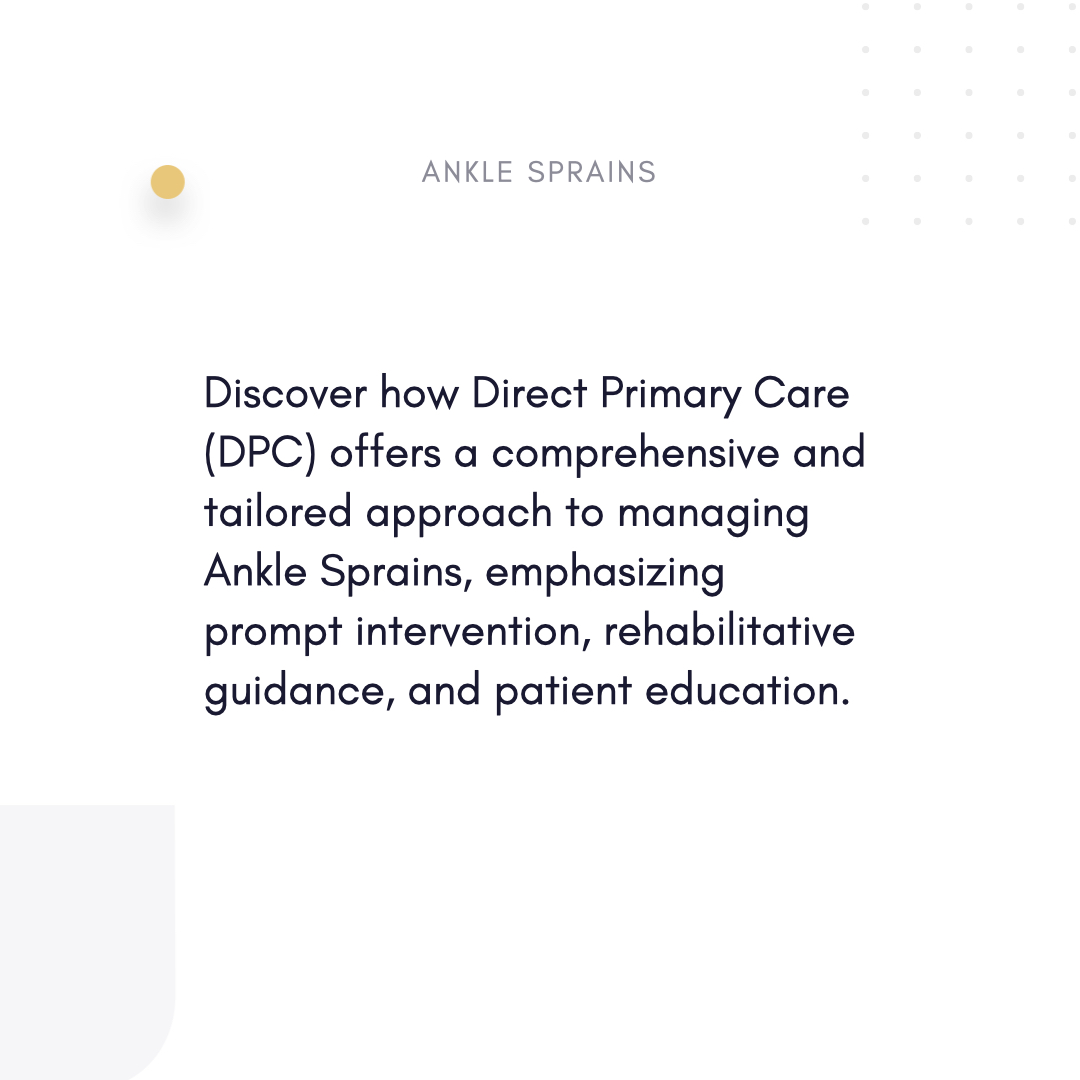Ankle Sprains and Direct Primary Care (DPC): Personalized, Proactive Recovery
Usually resulting from overstretch or tear ligaments, an ankle sprain causes limited mobility, pain, and swelling. Untreated, it can cause ongoing instability or re-injury. Direct Primary Care (DPC) guarantees complete recovery and helps to prevent complications by providing patient-centered management with fast diagnostics, tailored treatments, and continuous support.

Understanding Ankle Sprains: Crucial Challenges
- Causes: sports, uneven surfaces; abrupt rolls or impacts.
- Pain, swelling, bruises, weight trouble bearing, stiffness.
- evaluation: Grading
- Grade one: light ligament stretching.
- Grade 2: partial tear with instability.
- Grade 3: Complete tear with great unstability.
- Among the complications are arthritis, chronic pain, regular sprains.
DPC Makes Ankle Sprain Treatment Better
Direct Primary Care (DPC) is a membership model (USD 50–USD 150/month) whereby a basic care physician is always available. For those with ankle sprains, this means:
- no wait for urgent evaluations or follow-up visits.
- Open pricing—braces, discounted imaging, physical therapy.
- Holistic treatment addressing pain management, rehabilitation, and prevention.
1. Evidence-based treatment based on quick diagnosis
- Ottawa Ankle Rules help determine whether X-rays are needed for in-office exams, so sparing unnecessary imaging.
- MRIs or X-rays paid at cash-pay rates (USD 50–USD 200) will help verify degree of severity.
- Advice on the RICE protocol: rest; ice; compression; elevation to help reduce swelling.
2. Customized Approach of Treatment
DPC combines following American Academy of Orthopaedic Surgeons' (AAOS) and National Athletic Trainers' Association's (NATA) recommendations:
- Conservative business:
- For stability—grade 2–3 sprains—ankle braces or walking boots. braces or splints.
- Exercises in balance and proprioception support neuromuscular development aimed at preventing re-injury.
- NSAIDs, (ibuprofen), help with pain at wholesale rates (USD 5–USD 10/month).
- Physical therapy referrals include specifically designed exercises meant to restore flexibility and strength.
3. Prevention and Extended Support
- Strategies of rehabilitation: Gradual return-to-activity programs help athletes.
- Suggestions for shoes, taping techniques, change of lifestyle.
- Further care: follow-up Track healing and change courses of treatment to stop continuous instability.
DPC's Instant Access to Treatment Benefits Ankle Sprain Patients
- Acute injuries:
- same-day and started treatment right away.
- 24/7 telehealth support for direction on pain management.
- Tailored, Constant Treatment:
- recovery programs based on degree of damage and activity goals.
- Regular visits help to keep an eye on development and prevent failures.
- Reasonably cost treatments:
- Braces and splints run USD 20–USD 50 instead of USD 100+ retail.
- With insurance, USD 40–USD 70/session physical therapy pales in comparison to USD 120+.
DPC Specialized Ankle Sprain Management
- Regarding Grade 1 sprains:
- Early mobilization: Gentle activities meant to prevent stiffness.
- Compression wraps and ice packs assist in cryotherapy—that is, swelling control.
- Walking boots or braces protect healing ligaments from damage in Grade 2 through 3 sprains.
- Progressive strength training and agility exercises define structured rehabilitation.
- Among athletes:
- Sports-specific rehabilitation: Safe return with plyometric and sport simulation exercises.
- Programmes for warm-up and biomechanical analyses help to avoid injuries.
Real-Life Success Stories
- Case 1: 28-year-old Sarah avoided lifelong instability after her DPC doctor recommended an MRI and physical therapy. Six weeks later her ankle strength came back.
- Case 2: Mike saved USD 300 on a walking boot and PT using DPC's discounted rates; then he went back to basketball pain-free.
Ask Questions on Ankle Sprains and DPC
- Q: Can DPC treat extreme sprains requiring surgery?
A: DPC schedules visits to orthopedic surgeons and manages post-operative care.
- Q: I want to start physical therapy how soon?
A: DPC speeds referrals to prevent often within 48 hours stiffness.
- Q: Are covered X-rays available?
A: No, but DPC works on imaging cash-pay rates (USD 50–USD 100).
Why DPC Changes Ankle Sprain Treatment
- Sprain treatments stop recurrent issues. Early on intervention reduces re-injury risk.
- One source reviews imaging, bracing, and rehabilitation.
- Openness about costs: Affordable care ensures consistent adherence to treatment.
How DPC Especially Helps with Ankle Sprain Treatment
The DPC model excels in combining:
- Quick evaluations: Directed by the Ottawa Ankle Rules to direct imaging decisions.
- Customized rehabilitation programs: Complement NATA's conservative approach of treatment.
- Continuity: Constant observation to manage obstacles and change course of rehabilitation.
With DPC, Step Toward Recovery
Usually, ankle sprains have no long-term restrictions. DPC helps you find a partner dedicated to fast, reasonably priced treatment that guarantees total healing and return to your favorite activities.






